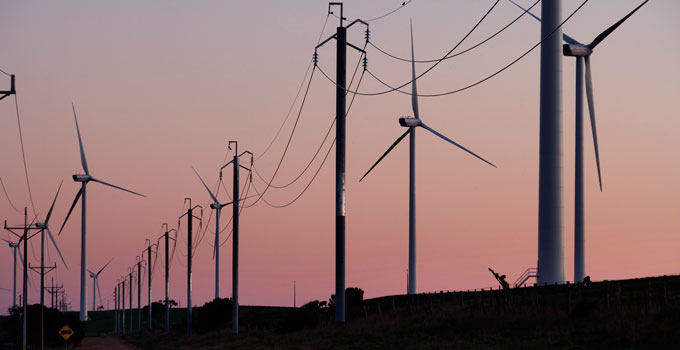THOUGHT LEADERSHIP
How can we manage a network with more renewables?
Can our network and market frameworks support two to three times more renewables in Australia in the next 10 to 15 years without radical or innovative actions?

Once upon a time, we had an electricity system that was dominated by large users and large producers, and everyone else just tagged along. It needed very few points of control. Demand was easy to predict, as was the availability and cost of generation.
This is increasingly not the case.
The predictability and consistency on which the market and the network relied are being eroded by changes in how we produce and consume electricity. The efficiency benefits of the market are being undermined and it seems unable to find a ‘new normal’ that works. At the same time, the technical robustness of the electricity supply is being undermined through the reducing share of dispatch of synchronous generation.
These effects are only beginning to emerge in the wider National Electricity Market (NEM). We are suffering from increasing uncontrollability, unpredictability and variability.
Uncontrollability
As wind and solar PV replace synchronous generation in the NEM, system inertia and fault levels will steadily decline, along with the availability of frequency-control ancillary services (FCAS, or ‘spinning reserve’). More self-dispatched generation also limits the market operator’s ability to efficiently manage transmission constraints.
Unpredictability
We can use statistical models to predict demand pretty accurately unless we factor in customer storage. Installation of uncontrolled storage adds a degree of uncertainty to the demand. The current pre-dispatch followed by real-time dispatch methodology may not be capable of dealing effectively and efficiently with this uncertainty. Furthermore, the factors determining take-up of new technologies are difficult to predict. This uncertainty makes it more difficult for network planners to forecast and hence maintain capacity in the network.
Variability
Increasingly, generation dispatch patterns (and load patterns in some regions) depend on non-market variables like sun and wind (and rain). This variability can lead to a wide range of valid system dispatches, which in turn may require a wide variety of network supports, such as reactive power support from SVCs and the like. Interconnector capacity requirements vary depending on dispersion or concentration of generation relative to demand.
How might a low-synchronous-generation network be managed?
In many ways Tasmania provides a glimpse of the future in terms of how a low-synchronous-generation network may be managed. Since Tasmania has been connected to Victoria, generators, major customers and the network service provider, with support from Entura, have collaborated to extend and enhance the Tasmanian power system’s ability to cope with what is already in excess of 70% non-synchronous generation under high wind and high import on the interconnector. While the interconnector can provide some frequency support, this support is capped within the capacity of the link.
The solution in Tasmania is to reduce demand for frequency control, increase capacity to supply frequency control and actively manage fault level and inertia. This has required detailed understanding of the power system dynamics within the Tasmanian power grid as well as innovative engineering to understand and adapt hydro generators to extend their capability or flexibility. The solutions range from tweaking the control systems of individual generating units to establishing and coordinating system-wide protection schemes and constraint equations.
This experience shows that understanding the fundamental characteristics of a power system and its likely operating modes, and a common purpose and resolve to enhance its operation, can lead to an expanded technical envelope in which the electricity market can seek a cost-effective outcome. It has required collaboration across the sector including equipment manufacturers, owners of windfarms, hydropower stations, interconnectors and large customers.
Can this experience be replicated elsewhere?
Different power systems may demand a different set of solutions, but the fundamentals remain the same. A functioning AC power system needs inertia, fault level, frequency and voltage control as well as energy sources to function to an acceptable standard. Each power system will have its own sweet spot for providing these requirements. Inverter-based generators (solar, wind and batteries) can provide inertia-like responses for instance and so may reduce reliance on synchronous machines for that requirement.
A bigger question is: will the market takes us there or will it lead us down a blind alley of misguided self-interest? We are already seeing some murmurings of market reform that may ultimately lead us to the right long-term solution, but I’m not sure that we can always rely on market-led transitions, especially where the transition has not been envisaged as part of market design. This may be a misplaced leap of faith.
It’s clear that no single solution is going to sort this out in most cases. It’s also clear that some level of collaboration will be required to make the transition work smoothly. The planner must also consider technological change and customer expectations; else we run the risk of over-capitalising on solutions only for them to become redundant and ‘stranded’.
Ultimately, we know the challenges are not insurmountable but we also know that the solution is likely to be arrived at through care and deliberation rather than market meanderings.
If you would like to find out more about how Entura can help you adapt successfully to the rapidly changing market for electricity generation and energy services, contact Donald Vaughan on +61 3 6245 4279 or Wayne Tucker.
About the author
Donald Vaughan is Entura’s Technical Director, Power. He has more than 25 years of experience providing advice on regulatory and technical requirements for generators, substations and transmission systems. Donald specialises in the performance of power systems. His experience with generating units, governors and excitation systems provides a helpful perspective on how the physical electrical network behaves and how it can support the transition to a high renewables environment.
MORE THOUGHT LEADERSHIP ARTICLES
26 August, 2016






